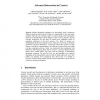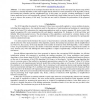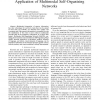682 search results - page 3 / 137 » Advances in Self-Organizing Maps |
AAAI
2004
13 years 7 months ago
2004
Representing lexicons and sentences with the subsymbolic approach (using techniques such as Self Organizing Map (SOM) or Artificial Neural Network (ANN)) is a relatively new but i...
HUC
1999
Springer
13 years 10 months ago
1999
Springer
Mobile information appliances are increasingly used in numerous different situations and locations, setting new requirements to their interaction methods. When the user's situ...
WSOM
2009
Springer
14 years 10 days ago
2009
Springer
This paper discusses biological aspects of self-organising maps (SOMs) which includes a brief review of neurophysiological findings and classical models of neurophysiological SOMs...
IJCNN
2000
IEEE
13 years 10 months ago
2000
IEEE
It is often reported in the technique literature that the success of the self-organizing feature map (SOM) formation is critically dependent on the initial weights and the selectio...
IJCNN
2006
IEEE
13 years 11 months ago
2006
IEEE
— Multimodal integration of sensory information has clear advantages for survival: events that can be sensed in more than one modality are detected more quickly and accurately, a...



